1943 Riot
In July 1943, Detroit erupted in a race riot that lasted three days. By the time order was restored, thirty-three people had been killed, 675 people were seriously injured, and 1,893 people had been arrested. Of those killed, twenty-five were Black, seventeen by police and eight by white mobs. The remaining dead were white people killed by Black mobs. All together, the riot caused more than $2 million in property damage ($29 million in 2018) and caused the city’s industries over one million hours in production for the war. A report written at the time understood that the riot emerged from white Detroiters resistance to Black Detroiters commitment to fighting for dignity. “The basic underlying cause of the Detroit Riot is, of course, the struggle of colored Americans for full, unrestricted, and nondiscriminatory enjoyment of the rights, privileges, and immunities of American citizenship under the Constitution and for nondiscriminatory participation in the political, economic, and social life of the American community.”
In the months before the riot, tension had been building on factory floors. Blacks, hired in large numbers in auto plants after the passage of Executive Order 4088 made discrimination in defense plants illegal, entered plants with a commitment to fight for their dignity. As autoworker and activist James Boggs told an interviewer, “Black workers began to create a new social milieu and an arena inside the plant.” Because Blacks were committed to having their dignity recognized, according to Boggs, “whites were confronted with many of the contradictions which they had been avoiding because of their privilege and isolation from Blacks. White men and women were forced to confront questions which they had never dreamed of—and which at the time seemed monumental. Would they or would they not sit on the same toilet stool as Blacks? Would they or would they not eat in the same restaurant as Blacks?” “Many times, the [assembly] line would grind to a halt because a white worker would answer these questions in the negative, believing confidently that the whole future of civilization depended on his refusing to sit on the same toilet stool as a Black man.”
These white workers’ refusal to work with Blacks who stood their ground resulted in several strikes throughout World War II that were made up of only Blacks and only whites. In the first six months of 1943 alone, twelve of these strikes occurred in Detroit, the most serious occurring at the Packard Automotive Plant. Black workers went on strike and shut the plant down to protest management’s refusal to promote Black workers. When a Black worker was promoted, whites then went on strike and shut down the plant to protest the promotion. In response to the hostility of white workers and police harassment, the UAW and the NAACP held a demonstration demanding that police take action against mobs of racist white workers. 25,000 white workers at Packard walked out and shut the plant down for three days just days after the demonstration.
This tension also existed in housing. Throughout the migration years 500,000 new Black and white residents moved into Detroit and needed housing. Because war spending was top priority, very little new housing was built during these years and a major housing shortage emerged. Thus, when new public housing was built and Black Detroiters were given access to it–such as the Sojourner Truth Housing Project–whites rioted not just out of racism but also because they needed housing and believed the city was neglecting their needs. Only in this context of building tension can the 1943 riot be explained and understood.
On an extraordinarily hot June 20, somewhere between 90-100,000 people gathered on Belle Isle to enjoy the weekend weather. Although the incident’s roots have never been exactly clear, there were several complaints filed to police that day about fights between Black and white men on Belle Isle as well as complaints filed by Black women about harassment from white men. Far more important to the spread of the riot were rumors about what happened, especially a rumor that white men had drowned a Black baby in the Detroit River and that whites had harassed a pregnant Black woman. These rumors were important fuel for the riot because they provided both Blacks and whites with a target on which to vent their frustrations.
As rumors of racist acts continued to spread, the riot spread down Woodward Avenue. On the east side where Blacks lived, rumors that whites threw a Black woman and her baby off a bridge drove anger and in white communities, rumors of a Black man raping a white woman fueled anger. Over the course of three days, Black Detroiters looted stores, fought the police, stoned white people, and attacked whites on streetcars in Black neighborhoods. White Detroiters came to Black Bottom in mobs and attacked individual Black Detroiters while also pulling Black people out of streetcars and automobiles, beating them, then setting their cars on fire.
This willingness of Blacks to fight back had a transformative impact on the city and on their white co-workers in factories. With the dignity and self-respect displayed by Black workers in Detroit during the war, Black people from throughout the city were emboldened to stand up for themselves and fight for democracy at home as it was being fought for abroad. This self-respect also led some whites to a new respect for Black Detroiters and mobilized them to struggle to improve their own lives. Over the course of the War James Boggs observed a growing tendency amongst white workers to prove to their Black co-workers that they were not racist.
Although a decline in racist sentiment is hard to prove, it is clear that Black resistance inspired whites to resist. Following the war, with workers of all backgrounds having been transformed by Black workers activism, a new unity emerged amongst workers. Consequently, the UAW was able to maintain an integrated strike at General Motors in 1946 for 115 days and several other integrated strikes were waged around the city.
References:
Matthew Birkhold, “Doing for Our Time What Marx Did for His: The Boggsian Challenge to Marxist Praxis,” Souls: A Critical Journal of Black Politics, Culture, and Society, Vol. 13, No. 3, 2011
Xavier Nichols, Questions of the American Revolution: Conversations with James Boggs, Atlanta, Institute of the Black World, 1976
Richard Walter Thomas, Life for Us is What We Make it: Building Black Community in Detroit, 1915-1945, Bloomington, University of Indiana Press, 1992
Stephen M. Ward, In Love and Struggle: The Revolutionary Lives of James and Grace Lee Boggs, Chapel Hill, University of North Carolina Press, 2017
Clips from 2018 interviews with Charles Ezra Ferrell and Helen Moore, in which they discuss the 1943 Riot in Detroit. –Videography: 248 Pencils
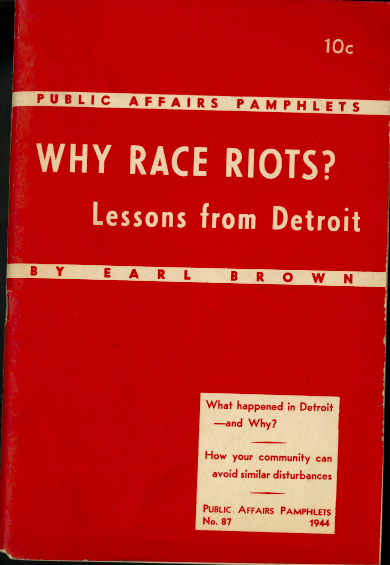
A 1944 pamphlet by Earl Brown, “Why Race Riots? Lessons from Detroit,” offers an analysis of the causes of the 1943 Riot.–Credit: Walter P. Reuther Library, Archives of Labor and Urban Affairs, Wayne State University
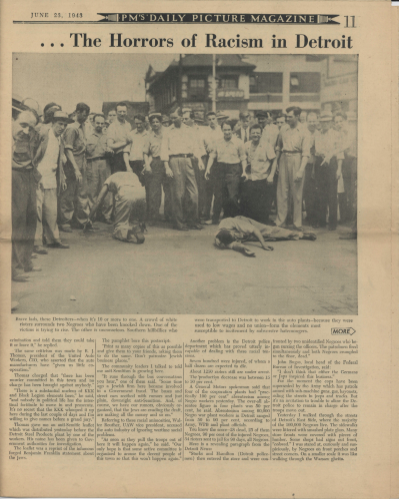
Pages from the June 23, 1948 edition of PM’s Daily Picture Magazine, including photos of racist violence during the 1943 Riot. –Credit: Walter P. Reuther Library, Archives of Labor and Urban Affairs, Wayne State University
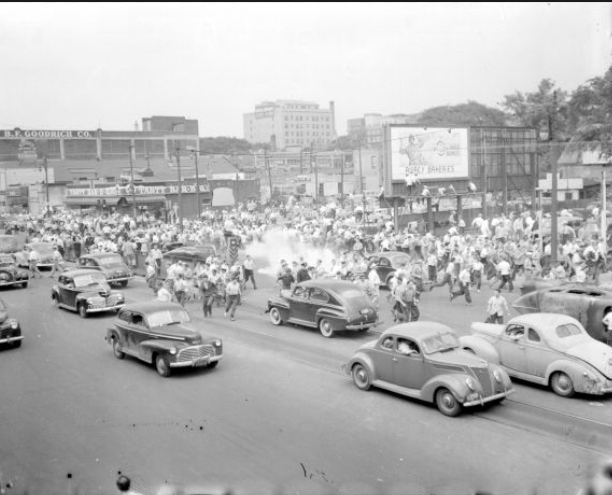
Tear gas disperses a crowd of people from the area near Woodward and Stimpson during the 1943 Riot.–Credit: Walter P. Reuther Library, Archives of Labor and Urban Affairs, Wayne State University
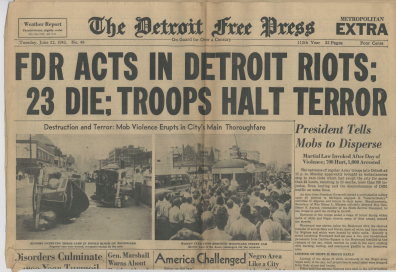
After 24 hours of violence, President Franklin D. Roosevelt invoked martial law and ordered federal troops into the city to end the riot. –Credit: Walter P. Reuther Library, Archives of Labor and Urban Affairs, Wayne State University
Explore The Archives
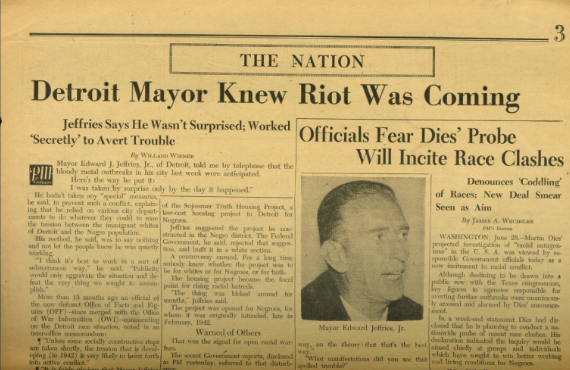
The 1943 Race Riot did not happen overnight, as this June 1943 article in The Nation explains. It was the result of decades of segregation, exploitation, police brutality, labor discrimination, and a major housing shortage in the midst of World War II.–Credit: Walter P. Reuther Library, Archives of Labor and Urban Affairs, Wayne State University.
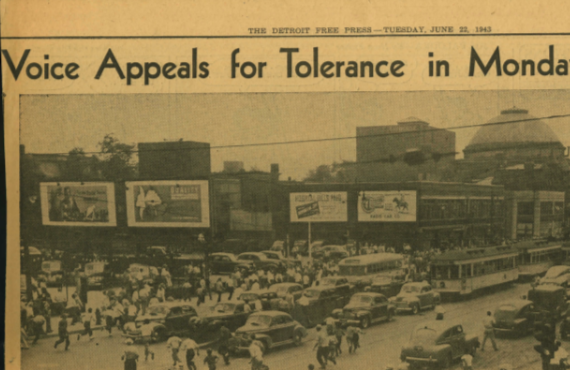
These photos by the Detroit Free Press published the day after the 1943 Race Riot on June 22, 1943 display the chaos and violence that occurred during the 1943 Race Riot.–Credit: Walter P. Reuther Library, Archives of Labor and Urban Affairs, Wayne State University
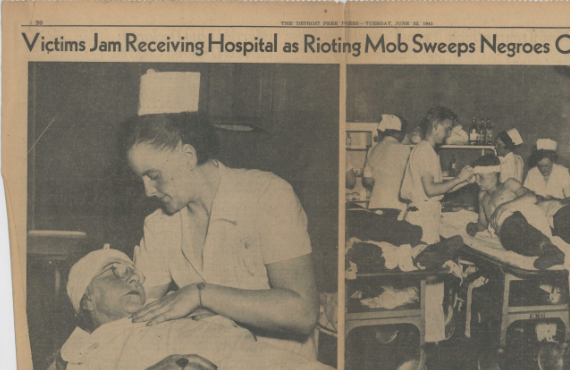
This June 22, 1943 article from the Detroit Free Press, titled “Victims Jam Receiving Hospital as Rioting Mob Sweeps Negroes Off Woodward,” shows photographs of violence and racial hostility during the 1943 Race Riot.–Credit: Walter P. Reuther Library, Archives of Labor and Urban Affairs, Wayne State University
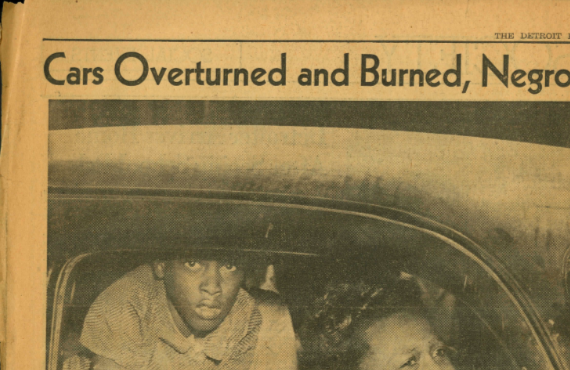
In this series of pictures published by the Detroit Free Press are a photo of a Black woman and what appears to be her son watching in horror as their husband and father is beaten by a mob. The two pictures below also demonstrate white hostility and racist violence that occured during the 1943 Race Riot.–Credit: Walter P. Reuther Library, Archives of Labor and Urban Affairs, Wayne State University
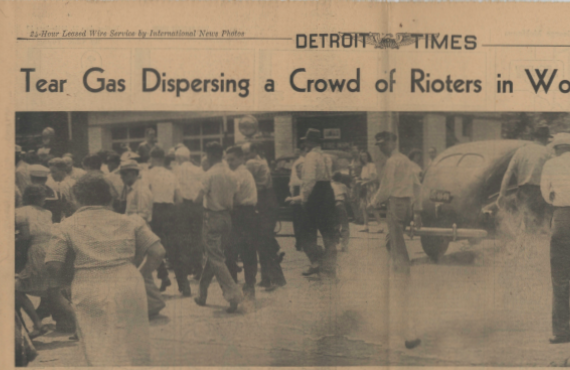
This June 22, 1943 Detroit Free Press article, titled “Tear Gas Dispersing a Crowd of Rioters in Woodward Avenue,” describes the major usage of tear gas during the riot among images of chaos and violence. Excluded from this particular article is the rampant white violence against often times random Black passerbys.–Credit: Walter P. Reuther Library, Archives of Labor and Urban Affairs, Wayne State University.
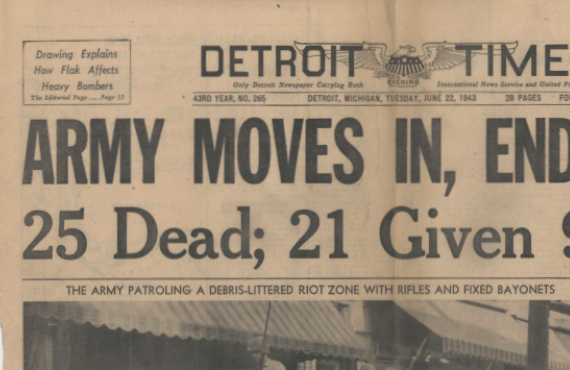
A June 22, 1943 article from the Detroit Times, titled “Army Moves In, Ends Riots: 25 Dead; 21 Given 90 Days.” Running alongside aritcles on the German Ruhr and Italian countryside “blasted” by bombers, the 1943 Detroit Race Riot draws graphic comparsions with the bombings of cities in Europe during World War II.–Credit: Walter P. Reuther Library, Archives of Labor and Urban Affairs, Wayne State University.
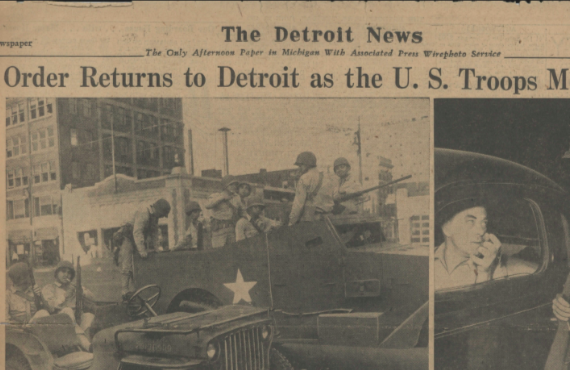
This article from the Detroit Free Press, “Order Retuns to Detroit as the U.S. Troops Move In,” includes photographs of the devestation and chaos wrecked upon the city during the 1943 Riot. Notably, despite the chaos and violence, those who worked at an autoplant were still permitted and in many cases encourgaed to continuing working normally.–Credit: Walter P. Reuther Library, Archives of Labor and Urban Affairs, Wayne State University
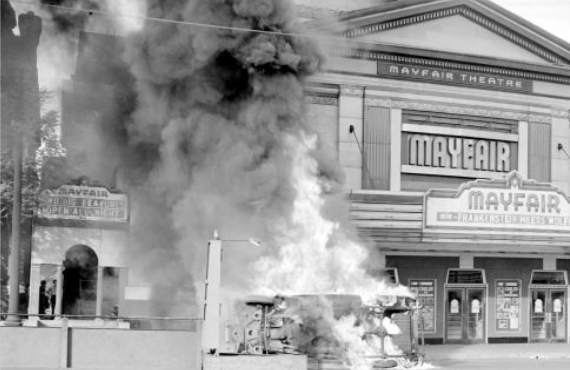
Oral history interview with former residents of Detroit’s Black Bottom neighborhood, conducted by Elaine Latzman Moon between 1990-1994. –Credit: Walter P. Reuther Library, Archives of Labor and Urban Affairs, Wayne State University
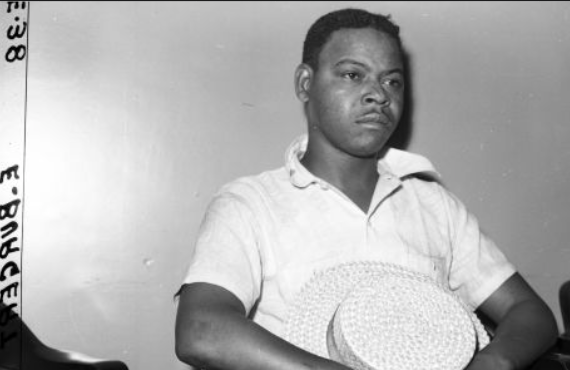
Portrait of Leo Tipton, sitting in chair holding his hat. Mr. Tipton and Charles (Little Willie) Lyons were charged with inciting a riot after they told a black crowd at the Forest Social Club (700 Forest Ave) that whites had thrown a black woman and her baby off the Belle Isle Bridge.–Credit: Walter P. Reuther Library, Archives of Labor and Urban Affairs, Wayne State University
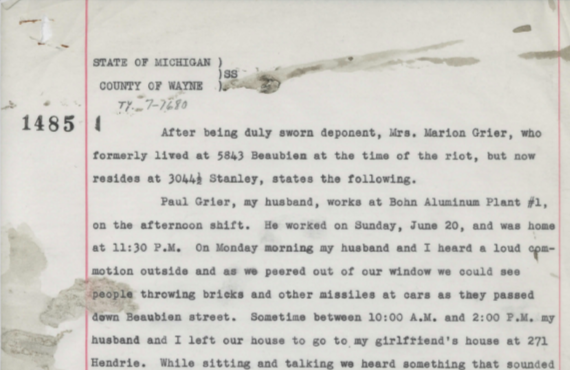
Mrs. Marion Grier files an affidavit about her husband being arrested by police because they suspected him as a suspect in a murder during the 1943 Riot.–Credit: Walter P. Reuther Library, Archives of Labor and Urban Affairs, Wayne State University
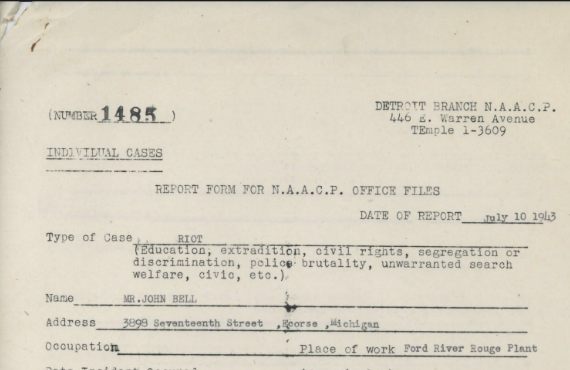
Mr. John Bell filed a complaint with the Detroit NAACP that while driving after work at the Ford River Rouge Plant, his car was attacked by a mob of “about 100 whites.” They pulled him out of his car, beat him, and when he reported it to the police, they “didn’t take any interest” in his story.–Credit: Walter P. Reuther Library, Archives of Labor and Urban Affairs, Wayne State University
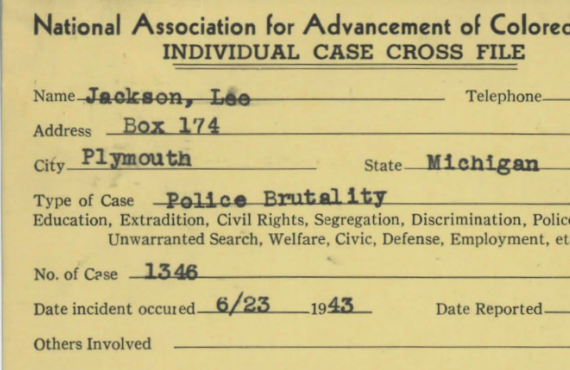
A case file card for a complaint of police brutality filed with the Detroit NAACP on June 23, 1943. NAACP individual case cards were used to catalogue the NAACP case files.–Credit: Walter P. Reuther Library, Archives of Labor and Urban Affairs, Wayne State University
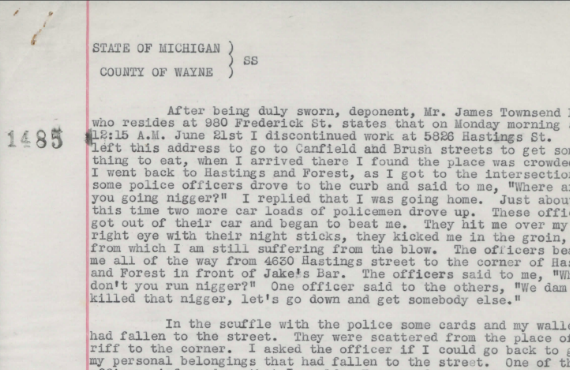
An affidavit filed by Mr. James Townsend Lee on June 30, 1943. Lee drove home from work on June 21 and shortly after was pulled over by police, beaten, arrested, and transferred from station to armory to station until finally charged and released on bond.–Credit: Walter P. Reuther Library, Archives of Labor and Urban Affairs, Wayne State University
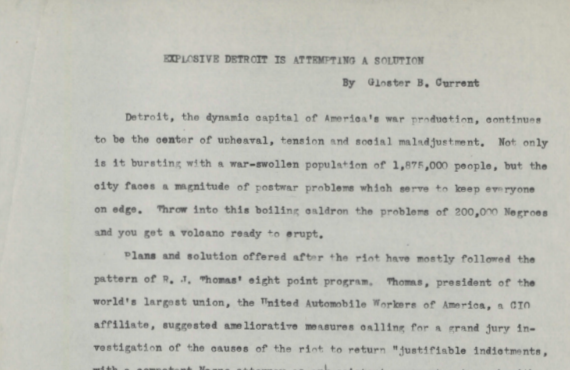
An undated speech (presumbly spoken shortly after the 1943 Riot) by Gloster Current, the Executive Secretary of the Detroit NAACP, titled “Explosive Detroit is Attempting a Solution.” Current discusses the 1943 Riot and in general the conditions that African Americans experienced before, during, and after the riot.–Credit: Walter P. Reuther Library, Archives of Labor and Urban Affairs, Wayne State University
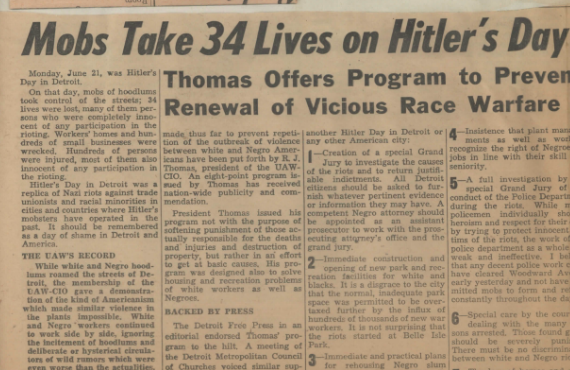
This July 1, 1943 article in a U.A.W. publication, titled “Mobs Take 34 Lives on Hitler’s Day in Detroit,” gives an anaylisis of the causes and explans what sort of solutions the UAW-CIO could offer to “prevent renewal of vicious race warfare.”The 1943 Race Riots not only reconfigured race relations in Detroit but also provided an impetus for many to consider the factors that caused it. –Credit: Walter P. Reuther Library, Archives of Labor and Urban Affairs, Wayne State University
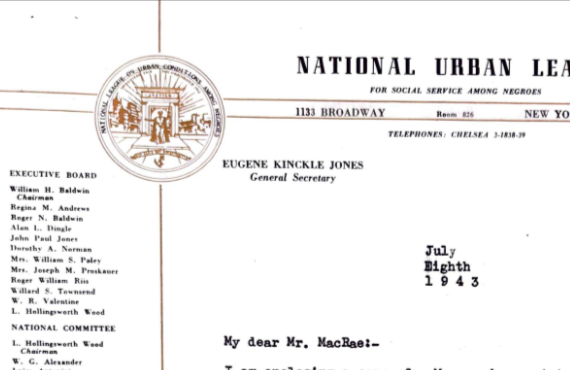
A letter from National Urban League Executive Secretary Lester Granger to Detroit historian Robert McRae on July 8, 1943, offering the services of the National Urban League to help address the causes of the 1943 Riot. –Credit: Walter P. Reuther Library, Archives of Labor and Urban Affairs, Wayne State University
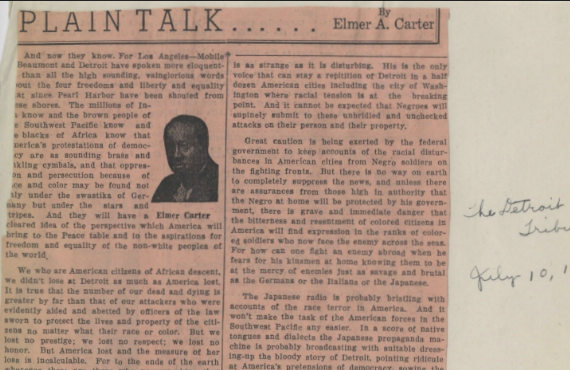
A July 10, 1943 article in The Detroit Tribune by Elmer A. Carter, titled “Plan Talk.” Carter wrote that Black Americans “didn’t lose at Detroit as much as America lost” and goes on to lament the negative effects racial discrimination and hostilities are having on the nation.–Credit: Walter P. Reuther Library, Archives of Labor and Urban Affairs, Wayne State University.
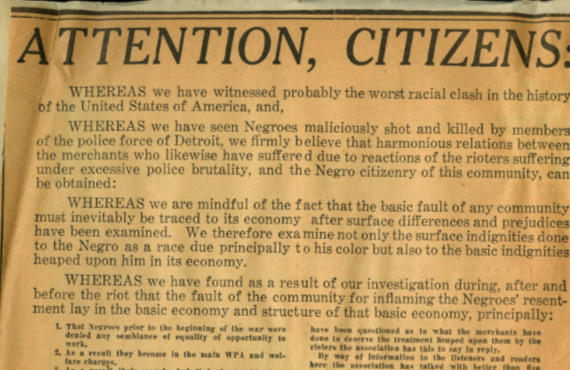
This article in the Detroit Tribune on June 10, 1943, was written by the Paradise Valley Coin Machine Operators Association to help members of the Black community most impacted by the riots; the poor, unemployed, injured, and windowed. The 1943 Race Riot impacted the entire city, but Black Bottom and Paradise Valley, the center of Black economic life in Detroit, were devasted by the riots. –Credit: Walter P. Reuther Library, Archives of Labor and Urban Affairs, Wayne State University
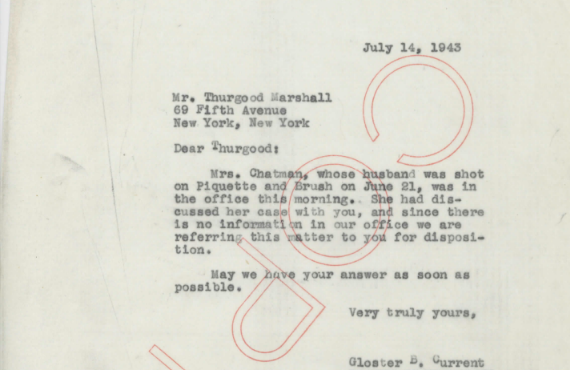
A July 14, 1943 letter from Gloster B Current, Executive Secretary of Detroit NAACP Chapter, to Thurgood Marshall, head of the NAACP’s Legal Defense Fund, discussing a case where a women’s husband was shot, presumbly during the 1943 Riot.–Credit: Walter P. Reuther Library, Archives of Labor and Urban Affairs, Wayne State University
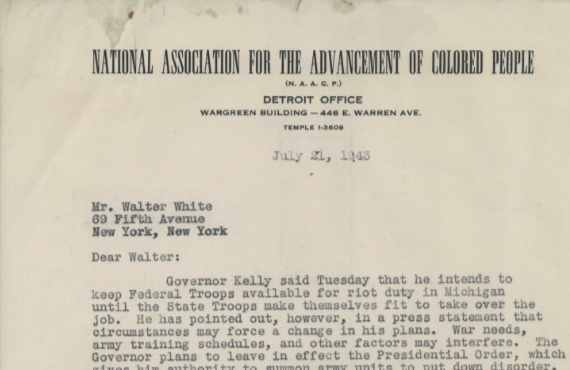
A July 21, 1943 letter from Gloster B. Current, exeuctive secretary of the NAACP Detroit Branch, to Walter White, Executive Secretary of the National NAACP. Current details how Governor of Michigan Kelly plans to keep Federal Troops in the city, the Mayor’s Committee that investigated the causes of 1943, and the future conditions of the city–Credit: Walter P. Reuther Library, Archives of Labor and Urban Affairs, Wayne State University.
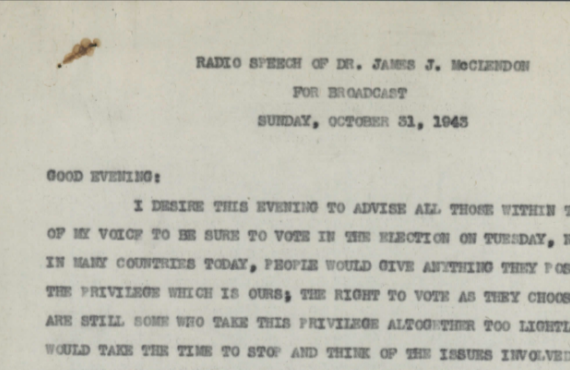
This radio speech delivered by Detroit NAACP President Dr. James J. McClendon on October 31, 1943 encouraged Black Detroiters to be active in politics and to vote for a slate of candidates. Dr. McClendon was president of the NAACP Detroit Branch from 1938 to 1945. –Credit: Walter P. Reuther Library, Archives of Labor and Urban Affairs, Wayne State University
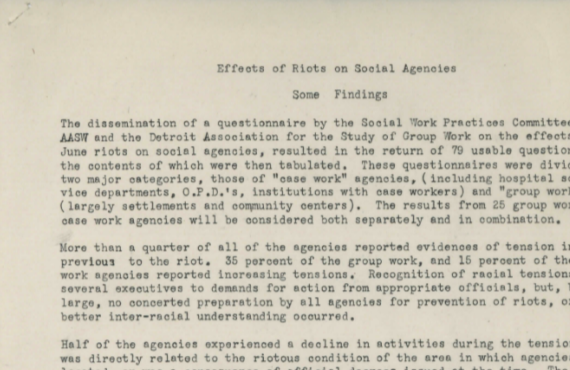
This undated study was written after the 1943 Detroit Race Riot, as many organizations attempted to “diagnose” the causes of the riot and analyze its impacts on the city.–Credit: Walter P. Reuther Library, Archives of Labor and Urban Affairs, Wayne State University.
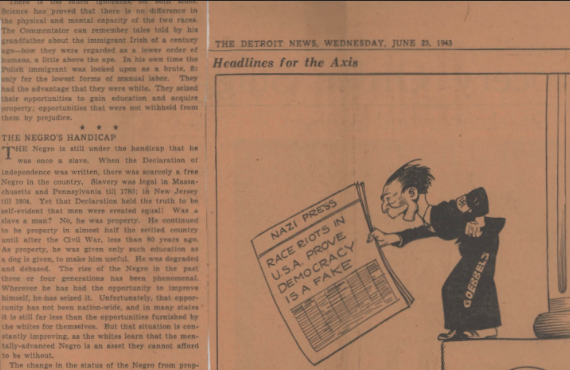
This political cartoon published in The Detroit News on June 23, 1943, is a carciture of Nazi propaganda minister, Joseph Goebbels, holding an article titled “Race Riots In USA Prove Democracy is a Fake.” The Nazis took advantage of the rampant racism prevelant in the United States and turned it into fodder for their propaganda machine, striking a blow at racial liberals within the FDR adminstration who sought to mitigate racial antimosity during World War II.–Credit: Walter P. Reuther Library, Archives of Labor and Urban Affairs, Wayne State University.
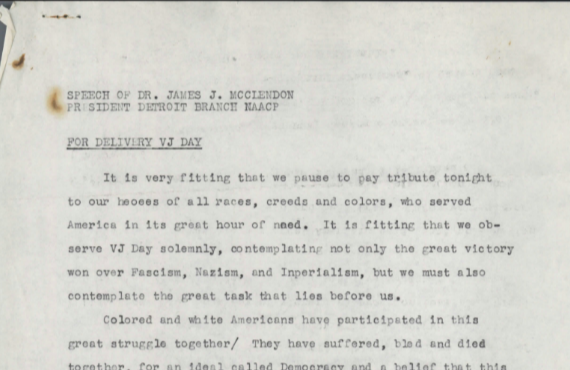
A speech delivered by Dr. James J. McClendon, President of the Detroit Branch NAACP, on the day World War II ended, also known as VJ or Victory in Japan day. He discusses the task that lies ahead in terms of ending racism and discrimination, and describes how African Americans contributed to the war effort.–Credit: Walter P. Reuther Library, Archives of Labor and Urban Affairs, Wayne State University

The Detroit Branch of the NAACP response and reccomendations to the Mayor’s Committee on the 1943 Riot, focused on policing, recreation, education, housing, labor, and reparations.–Credit: Walter P. Reuther Library, Archives of Labor and Urban Affairs, Wayne State University
